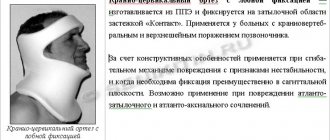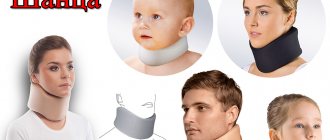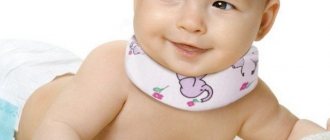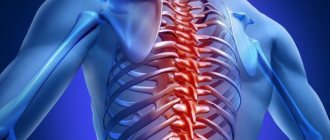How does an orthopedic collar work?
Many people who have had to deal with unpleasant sensations in the neck area are interested in how an orthopedic collar works. This device is also known as a Shants collar (or splint). Its main purpose is to gently fix and stabilize the cervical spine. It helps to provide soft support to the head, as well as partially relieve the musculo-ligamentous apparatus of the cervical spine.
In other words, the Shants collar makes it possible to fix the cervical spine in the required position, and also limits excessive mobility of the cervical vertebrae. The result is a gentle correction of the neck position, slight traction and a weak massage effect.
Price
The price of an orthopedic collar depends on the material, its consumption, design complexity, manufacturer, and the availability of replaceable elements.
In Russia, a polyurethane foam neck brace costs 400–500 rubles, and a semi-rigid polyethylene foam neck brace costs 500–700 rubles. (Made of open-cell foam polymer - up to 5,000 rubles, equipped with a removable hard tire - up to 7,000 rubles). An inflatable “relaxator” costs about 800 rubles, a hard one, such as “Philadelphia” - 1600–3700 rubles.
Cost in Ukraine:
- Shants' soft collar - 150–300 UAH;
- pneumatic collar - 150–200 UAH;
- cervical orthosis of moderate rigidity made of foamed polymer - 200–800 UAH;
- rigid head holder - 400–2000 UAH.
Indications and contraindications for use
The main indication for the use of a splint collar is a variety of diseases of the cervical spine. In addition, this device can help in the prevention of a wide range of diseases of the cervical-collar area, which primarily affect office workers who spend a lot of time at the computer. The collar makes it possible to remove the load from the muscular frame of the neck and at the same time supports the head. In addition, it has a very gentle cervical massage effect and at the same time helps to ensure immobilization of the neck during the recovery process after injury.
All of the above determines the main indications for the use of an orthopedic collar. Thus, it has proven itself well in cases of osteochondrosis and moderate injuries of the cervical spine. Its use is recommended for myositis - in other words, muscle inflammation of various etiologies. Pediatricians recommend wearing a Shants collar to newborns if they have been diagnosed with symptoms of muscular torticollis. This device also helps to recover from injuries and surgical interventions, helps with postural disorders, spinal cord compression and neurological pain.
At the same time, despite the undoubted effectiveness of the orthopedic collar, there are a number of diseases for which its use is categorically not recommended. Thus, you should avoid using the Shants collar if you have any dermatological diseases in the shoulder and neck area. In addition, it is not suitable for patients with too severe a spinal injury or with significant spinal instability in the cervical region. In this case, other, much more difficult to use, means will be needed.
Who is this bandage for?
The therapeutic corset has many indications. It should be worn for osteochondrosis, torticollis, pain in the neck muscles, muscle inflammation, scoliosis, sprains, fractures and other pathological conditions. It will provide an effective therapeutic result. But it is also worth remembering the contraindications. It is prohibited to wear a corset in cases where the cervical segment is severely destabilized, as well as when there are skin pathologies.
An orthopedic device with a warming effect will fix the neck, eliminate pain due to osteochondrosis changes, improve microcirculatory processes and relax the neck muscles
Types and properties of the Shants collar
Orthopedic collars have several varieties, which differ mainly in the material of manufacture. There are no functional differences between them. However, in order to choose the right Shants collar, you should definitely consult a doctor.
Soft tire
In order to provide easy traction of the cervical vertebrae and suppress the unpleasant symptoms that arise during sedentary work, orthopedists recommend using a therapeutic soft collar (splint). It is usually made from special medical foam rubber or other material characterized by increased elasticity and porosity.
Externally, such a collar is a flexible strip that has a special anatomical notch designed for the chin, as well as Velcro, with which you can reliably fix the position of the neck.
This orthopedic device limits head tilt and also prevents the development of cervical osteochondrosis. The mechanism of action of such a collar is that dosed pressure helps relieve the load on the cervical spine and also promotes damping traction.
Wearing such a splint is usually recommended for children, in particular in the case of torticollis in newborns. In addition, it has proven itself well as an adjuvant for myositis, osteochondrosis, as well as for rehabilitation after cervical injuries.
Inflatable collar
An inflatable collar is a frame that is made of a material that is high density, but at the same time flexible. An inflatable mechanism is located between the strips of the base material. Such devices are inflated using a special bulb.
The purpose of such a collar is to gently stretch the spinal column and stimulate blood flow. At the same time, it allows you to fix the spine in the required state and slightly limits the mobility of the neck.
Semi-rigid and rigid collars
The main purpose of an orthopedic collar with semi-rigid and rigid fixation is to support the head, thereby relieving the load on the muscles and vertebrae of the cervical spine.
A semi-rigid collar is usually made of polyurethane. The entire structure is covered in fabric and has a clasp at the back. The collar helps to support the head in a certain position, and in addition, has a warming effect, due to which it has a positive effect on problems of the muscular-articular system. This device is used for diseases of the cervical spine, when it is extremely important to limit the mobility of the neck. For example, it is used for minor fractures or cracks of the cervical spine, for dislocations, as well as during the rehabilitation period after surgical operations. It can be used either with a cotton fabric lining or simply on a naked body. It has several sizes, varying in neck circumference (from 30 to 46 centimeters), and height varies from eight to twelve centimeters.
The main difference between a rigid collar and a semi-rigid one is that when using it, the motor activity of the cervical spine is almost completely limited, since it is made of a rigid thermoplastic material. It is modeled individually, directly on the patient’s body, and then fixed from behind. It is recommended for use during postoperative recovery during operations on the neck muscles, as well as for any spinal injuries in the cervical region.
The rigid collar design always includes submandibular and posterior supports, which help provide significant immobilization. Rigid collars are used for fracture-dislocations, torticollis, as well as for severe instability of the vertebrae of the cervical spine, to eliminate the consequences of fractures of the cervical spine. A rigid collar is made of metal or hard plastic, which reliably fixes the spinal column in one position. At the same time, there are often cases when prolonged wearing of a hard collar led to ischemic problems, as well as pain in the chin and lower jaw.
Orthopedic collar for children
Separately, it is worth mentioning orthopedic collars intended for children. Doctors recommend wearing a Shants collar for children who need to temporarily limit the mobility of the cervical spine. The most common cause of this is a variety of neck injuries.
A children's orthopedic collar is a strip, which is usually made of highly elastic polyurethane. Such a device clasps and gently fixes the baby’s head and neck in exactly the position that is currently physiologically beneficial. At the same time, there is also stretching of the muscles cramped by spasm, restriction of excessive mobility of the cervical spine, blood circulation is stimulated and pressure on the nerve endings is reduced.
The Shants collar helps return displaced cervical vertebrae to the correct position, eliminates associated pathologies, and helps avoid accidental injuries to the cervical spine. It is also recommended to wear it during the rehabilitation period after surgery.
It should be noted that although an orthopedic collar helps return displaced cervical vertebrae to the correct position, its wearing should be combined with other treatment methods. This could be massage, gymnastics, or the use of an orthopedic pillow.
Children's orthopedic collars vary in size, which depends on the circumference and height of the child's neck. The latter is measured from the middle of the collarbone to the angle of the lower jaw.
An orthopedic collar is put on the child in such a way that the baby’s chin is located in the notch located in the middle of the upper edge of the device. The design is fastened on the back of the neck with Velcro. Be sure to ensure that the collar fits tightly against the skin over the entire surface of the neck. In this case, the child’s chin and cheeks should not “fall” inside the structure.
At the same time, you should also not fasten the collar too tightly. This can lead to breathing and circulation problems in the cervical spine.
Orthopedic collar for newborns
There is also another special category of orthopedic collars - Shants collars for newborns. These devices are known among young mothers as “collars.”
The Shants collar for newborns is a collar made of foam rubber with a height of 3.5 to 4.5 centimeters. At its ends there are Velcro strips that help regulate the volume of the tire.
Orthopedic collars for newborns are intended for use by children up to six months. Indications for wearing it are not only torticollis and problems with the cervical spine, but also hyperexcitability, some movement disorders, short neck syndrome, etc. Naturally, the final conclusion about the need to use this device in each specific case is made by the doctor.
As a rule, the use of a Shants collar is prescribed to a baby immediately after birth. The duration of its use is a month, but other options are possible. The peculiarity of the Shants collar for newborns is that it should be worn constantly, taking off only when bathing the baby. Less commonly, doctors recommend wearing this design in so-called “sessions” for 10-15 minutes a day.
Many young mothers share the misconception that due to the use of this device, the child will later learn to hold his head up. However, in reality this is not the case. An orthopedic splint for newborns does not interfere with the baby - it just limits movements that could cause him pain. In addition, this device has a slight warming effect and relaxes the muscles, as a result of which the baby becomes calmer and hyperexcitability goes away.
Please note that the orthopedic collar for newborns is put on the baby in such a way that there is a free space of approximately a finger's width between the neck and the structure. Its presence is usually checked on the posterolateral surface of the neck.
The main thing that parents need to remember, whose baby the doctor recommended wearing a Shants collar for newborns, is the fact that the baby’s skin under the splint should always be clean and dry. Otherwise, irritation, redness and soreness may occur.
With prolonged use, the children's orthopedic collar becomes dirty. Therefore, it would be advisable to purchase two or more products at once so that you can wash them alternately. Washing should be done very carefully, without using synthetic detergents. It is best to wash orthopedic collars for newborns by hand using baby or laundry soap. The tire should be dried flat, away from heat sources. After the bandage has dried, carefully inspect it - there should be no folds on it that could irritate the baby's delicate skin.
Features of use in the treatment of children
The duration of wearing the device for torticollis in a newborn depends on the speed of recovery (5-6 months). The doctor may discontinue its use if the next examination reveals complete elimination of the pathology.
Soft Shants collars are most often used to treat children, so hypoallergenic materials are used in their manufacture, and the design does not contain dangerous hooks or buttons. If the child experiences discomfort, you should consult a doctor. He will clarify the size of the product and, if necessary, adjust the wearing pattern.
How to choose a Shants collar
To ensure that wearing a Shants collar does not cause severe discomfort, several important nuances should be taken into account when choosing.
First of all, remember that once the splint is in place, neck mobility will be limited. It will be impossible to tilt your head back or tilt it forward. Therefore, the collar is put on exclusively in a position where the neck is straight and the head is level.
The height of the collar is important. The lower part of the Shants collar in front should rest against the bones of the collarbone, and in the back it should be located right at the base of the neck. The upper edge of the accessory should support the jaw in front and reach the base of the skull at the back.
A properly selected collar should not rub the neck, interfere with swallowing and lower jaw movements, squeeze the neck, or prevent head turning. One finger should fit freely between the skin and the inner surface of the bandage.
If the collar is not chosen correctly, patients may complain of a number of unpleasant symptoms. This may include weakness, attacks of dizziness, fainting, nausea and vomiting, severe pain in the neck muscles and lower jaw. If any of these symptoms occur, the cervical collar should be removed and medical advice sought. The specialist will suggest using a different modification of the design or adjust the degree of its compression.
Reviews about the effectiveness of the Shants collar
The effectiveness of using the Shants collar is confirmed by numerous positive reviews from patients. People note that when using this accessory, painful sensations quickly disappear, and wearing it is quite comfortable. Office workers are especially pleased with the use of the Shants collar - in particular, those who have to sit at a computer for a long time. Also, some note the positive effect of the collar during hypothermia.
There are, however, those who complain about the lack of any effect or discomfort caused by using the Shants splint. In particular, some claim that their headaches have worsened. The cause of this reaction is usually the wrong choice of collar or using it for too long a time.
What nuances matter when choosing a product?
First of all, when choosing a product, you need to rely on your doctor’s recommendations.
The Philadelphia bandage is worn strictly as prescribed by a medical specialist. We do not recommend taking measurements yourself to select such a bandage.
If we are talking about a Shants tire, then taking measurements on your own is quite acceptable, but to do this you must strictly follow the rules.
When purchasing an orthopedic product, you must make sure that the material it is made of is hypoallergenic and washable. This must be stated in plain text on the packaging. You also need to make sure that the fasteners of the product are in working order.
How long to wear a Shants collar
Patients for whom a doctor has prescribed the use of a Shants collar are interested in the question of how long this device should be worn. Alas, there are no universal recommendations on this matter. The duration of use of the device in each specific case should be determined by a doctor.
Most often, for minor injuries and pain, adults are advised to use an orthopedic collar for approximately a quarter of an hour daily. For people suffering from osteochondrosis, doctors usually advise using the collar twice a day for an hour, for example, while reading or watching TV.
It should be borne in mind that although you can sit and walk in the collar, you should never lie in it, because in this position strong pressure on the fixed cervical spine can lead to deformation of the vertebrae. In addition, it is strictly forbidden to wear an orthopedic collar all the time, as this can lead to complete atrophy of the neck muscles.
Doctors recommend combining the use of the Shants collar with physical therapy, massage, and the use of an orthopedic neck pillow.
Wearing rules
The wearing pattern is determined by the attending physician. It takes into account the stage of the pathology, the degree of damage to cartilage and bone tissue, and the likelihood of complications. The orthopedic device is used from the first days of therapy. Wearing it is always combined with physiotherapeutic and massage procedures. During daily exercise therapy and gymnastics, the collar must be removed.
Typically, wearing time does not exceed 4 hours a day. The collar must be removed before going to bed or during the daytime rest, since in a lying position it strongly compresses soft tissues and blood vessels. Constant use of the device causes a decrease in the tone of the skeletal muscles of the neck, and in severe cases, muscle atrophy.
But in some situations, the doctor may recommend not to remove it even at night, for example, during the rehabilitation period after fractures. To improve the quality of sleep and prevent compression of the vertebral artery, it is necessary to use an orthopedic pillow with a recess for the shoulder.
Orthopedic neck pillow
An orthopedic neck pillow is another way to prevent pain and the development of diseases of the cervical spine. The main target audience of these accessories are office workers, travelers, drivers - in short, those who, due to their occupation, are forced to sit for a long time. This device will also benefit all patients suffering from osteochondrosis.
Types of cervical orthopedic pillows
Today, there are several types of cervical orthopedic pillows. They differ in their purpose, form factor, and the filler used by the manufacturer.
The most popular are the collar pillow and the bolster pillow. Let's take a closer look at them.
The collar pillow is also often called the “travel pillow.” It is shaped like a horseshoe and is designed specifically for those who spend a lot of time on trains, planes and buses. During a trip, even if the chair is quite comfortable, the neck muscles do not get the opportunity to rest due to being in a sitting position. It is this problem that the orthopedic “horseshoe” is designed to solve, which tightly clasps the neck from the back and sides, fixing the person’s head in the most natural position. As a result, the load on muscle tissue is reduced, and a person has the opportunity to relax and even fall asleep in a sitting position. It is noteworthy that after sleeping with such a pillow, there is no unpleasant sensation in the neck, so familiar to those who have had to repeatedly doze off in transport.
An orthopedic cushion cushion is a cushion of variable thickness. It can also be used for sedentary work. In particular, this accessory is extremely popular among drivers, as it provides support for the head and neck, without limiting their mobility or blocking their view. In addition, it can be used by people who spend a lot of time on the computer.
There is also an orthopedic pillow called a double bolster. It consists of two rollers of different heights and is intended for sleeping. Thanks to its unique form factor, you can sleep on this pillow in different positions: on your back, using a high bolster; on the side, using either a high or low bolster, depending on how firm the mattress is; on the stomach using a low roller.
Orthopedists say that such pillows provide excellent support for the head and neck, helping to relax muscles and normalize sleep. It is noteworthy that such a pillow is placed only under the head and neck, while the person’s shoulders lie directly on the mattress, due to which there is no deformation of the spine.
An important role, however, is played not only by the form factor of the orthopedic pillow, but also by what kind of filler the manufacturer used.
Rating of popular models with soft fixation
Ecoten OB
A good orthopedic collar, which is intended for adults. The product is simple and easy to use. There is a removable cotton cover. The product has a comfortable anatomical shape, so there will be no problems with wearing it.
Fixation is easy, the product is not suitable for the treatment of complex pathological diseases. The collar provides the neck with sufficient warmth and comfort, which promotes rapid recovery and complete muscle relaxation.
The average cost is 300 rubles.
Ecoten OB with soft fixation
Advantages:
- Made from durable materials;
- Low cost;
- Convenient fixation;
- Virtually no restrictions on movement;
- Suitable for preventive purposes.
Flaws:
- Not recommended for use to treat serious illnesses.
Comf-Ort K-80-06
A convenient product that is sold in various pharmacies. The collar promotes muscle relaxation and proper blood circulation. The degree of fixation is weak, so you should not count on recovery from complex diseases. Special Velcro are used as fasteners. A high-quality case is included. Foam rubber and textiles are used for production.
The average cost is 480 rubles.
Comf-Ort K-80-06
Advantages:
- Complete muscle relaxation;
- Comfortable degree of fixation;
- High quality material;
- Low cost.
Flaws:
- Not found.
Ecoten OB for children
A high-quality children's collar that has a warming effect. The product is completely elastic, so there will be no problems with wearing it. There are tires and Velcro fastening. Weak fixation does not greatly restrict movement; there will be no problems with movement. The material used is foam rubber and textiles. The product is found in many pharmacies, so finding it will not be difficult.
The average price is 230 rubles.
Ecoten OB children's collar
Advantages:
- Positive reviews;
- The child does not experience discomfort;
- Reliability;
- High-quality execution;
- Easy to use.
Flaws:
- Not detected.










